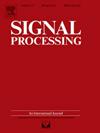Imputation of time-varying edge flows in graphs by multilinear kernel regression and manifold learning
IF 3.4
2区 工程技术
Q2 ENGINEERING, ELECTRICAL & ELECTRONIC
引用次数: 0
Abstract
This paper extends the recently developed framework of multilinear kernel regression and imputation via manifold learning (MultiL-KRIM) to impute time-varying edge flows in a graph. MultiL-KRIM uses simplicial-complex arguments and Hodge Laplacians to incorporate the graph topology, and exploits manifold-learning arguments to identify latent geometries within features which are modeled as a point-cloud around a smooth manifold embedded in a reproducing kernel Hilbert space (RKHS). Following the concept of tangent spaces to smooth manifolds, linear approximating patches are used to add a collaborative-filtering flavor to the point-cloud approximations. Together with matrix factorizations, MultiL-KRIM effects dimensionality reduction, and enables efficient computations, without any training data or additional information. Numerical tests on real-network time-varying edge flows demonstrate noticeable improvements of MultiL-KRIM over several state-of-the-art schemes.
基于多线性核回归和流形学习的时变边流图的插值
本文将最近发展起来的多线性核回归和流形学习(MultiL-KRIM)的框架扩展到图的时变边缘流的估计。MultiL-KRIM使用简单-复杂参数和霍奇拉普拉斯算子来结合图拓扑,并利用流形学习参数来识别特征中的潜在几何形状,这些特征被建模为嵌入在再现核希尔伯特空间(RKHS)中的光滑流形周围的点云。遵循光滑流形的切线空间的概念,线性近似补丁被用来为点云近似添加协同过滤的味道。与矩阵分解一起,MultiL-KRIM效果降维,并实现高效的计算,不需要任何训练数据或额外的信息。对实时网络时变边缘流的数值测试表明,MultiL-KRIM比几种最先进的方案有显著的改进。
本文章由计算机程序翻译,如有差异,请以英文原文为准。
求助全文
约1分钟内获得全文
求助全文
来源期刊

Signal Processing
工程技术-工程:电子与电气
CiteScore
9.20
自引率
9.10%
发文量
309
审稿时长
41 days
期刊介绍:
Signal Processing incorporates all aspects of the theory and practice of signal processing. It features original research work, tutorial and review articles, and accounts of practical developments. It is intended for a rapid dissemination of knowledge and experience to engineers and scientists working in the research, development or practical application of signal processing.
Subject areas covered by the journal include: Signal Theory; Stochastic Processes; Detection and Estimation; Spectral Analysis; Filtering; Signal Processing Systems; Software Developments; Image Processing; Pattern Recognition; Optical Signal Processing; Digital Signal Processing; Multi-dimensional Signal Processing; Communication Signal Processing; Biomedical Signal Processing; Geophysical and Astrophysical Signal Processing; Earth Resources Signal Processing; Acoustic and Vibration Signal Processing; Data Processing; Remote Sensing; Signal Processing Technology; Radar Signal Processing; Sonar Signal Processing; Industrial Applications; New Applications.
 求助内容:
求助内容: 应助结果提醒方式:
应助结果提醒方式:


